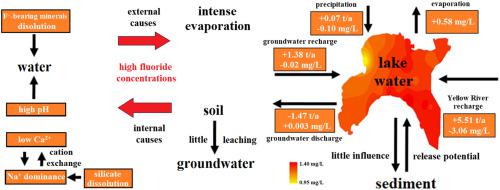Applied Geochemistry ( IF 3.1 ) Pub Date : 2021-01-09 , DOI: 10.1016/j.apgeochem.2021.104869 Linfeng Tian , Xiang Zhu , Longmian Wang , Fuquan Peng , Qingqing Pang , Fei He , Bin Xu

|
Fluoride (F−) pollution is a serious global problem. However, relatively few studies have evaluated the occurrence mechanisms of F− from an entire lake system perspective and determined their major causes via quantitative analysis. This study analyzes the distribution and occurrence mechanisms of F− in the lake water, sediment, groundwater, and soil of Shahu Lake, as well as assessing the influence of the factors on the F− in the lake water via quantitative analysis. Our results show that the F− concentrations in groundwater are higher in the eastern area of the lake, which is different from that in the surface soil layer. The F− concentrations in the lake water vary from 0.95 to 1.40 mg/L, most of which exceed Chinese standards (1 mg/L). Groundwater F− concentrations at 35% of the sampling sites exceed 1 mg/L. The total F− in the soil is significantly higher than the global mean. Ca2+-deficiency (which is mainly accelerated by cation exchange between Ca2+ and Na+) together with alkaline water conditions and intense evaporation are the major contributors of F− enrichment in groundwater. The groundwater hydrochemistry is suitable for the dissolution of F−-bearing minerals. The F− in soil is not easily leached into groundwater. Approximately 6.96 t of F− is deposited into Shahu Lake annually, where 79.17% of the F− originates from water recharge. Evaporation is the main direct cause of high F− concentrations in the lake, whereas water recharge and obstructed surface water exchange are indirect causes. To effectively decrease the F− concentrations in the lake water, water exchange within the Shahu Lake system should be enhanced, or at least 4.42 million m3 of lake water should be pumped out of the system before anthropogenic water recharge, with identically increasing volumes.











































 京公网安备 11010802027423号
京公网安备 11010802027423号